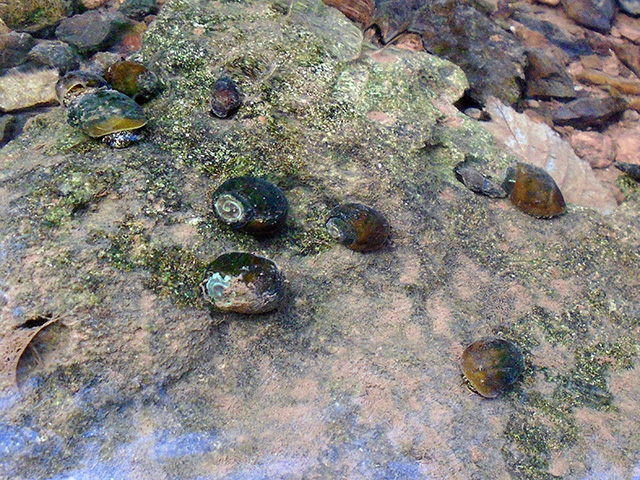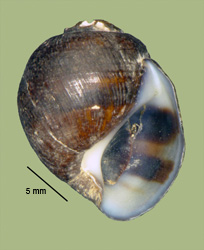"Athearnia anthonyi"
> Habitat & Distribution
As is true for other members of the genus, Leptoxis crassa populations seem to require rock substrates in rapid sections of free-flowing rivers. At one time the species ranged from the junction of the Powell and Clinch Rivers north of Knoxville down the Tennessee River into north Alabama, including the lower reaches of the French Broad, Little Tennessee, and Elk Rivers (Goodrich 1940). With the nearly complete impoundment of this historic range and development for navigation, today the species is apparently restricted to lower reaches of the Sequatchie River in Marion County, TN, the Tennessee River in the vicinity of the Sequatchie, and Limestone Creek in north Alabama (Minton & Savarese 2005, Garner & Haggerty 2010).
Leptoxis crassa was added (as "Athearnia anthonyi") to the federal endangered species list on 04-15-1994 (USFWS 1994, 1997). From 2003-2008 an "experimental population" was established in the main Tennessee River below the Wilson Dam in northwest Alabama. FWGNA incidence rank I-1, rare.
The habitat of L. crassa is generally described as the shoal areas of larger rivers, "on larger submerged objects (rocks, snags, etc.) in the transition areas between riffles and pools" (Dillon & Ahlstedt 1997).
> Ecology & Life History
Pleurocerids are aphallic; females distinguishable by an egg laying groove on the right side of their foot. The population of L. crassa inhabiting Limestone Creek is apparently perennial and iteroparous, as is typical. Two years seem to be required for maturity in most pleurocerid populations (Life cycle Hi of Dillon 2000: 156-162) although Garner & Haggerty (2010) suggested that only a single year may be required in the Limestone Creek L. crassa (Life cycle G). Eggs are affixed to hard substrates singly or in small clusters from spring to midsummer. Pleurocerids are generalized grazers, and where present in high density can have significant effects on energy flow in streams (Dillon 2000: 86-91).
> Taxonomy & Systematics
At least three genus names and two species names are in currency for this single species of snail. Goodrich (1931, 1940) preferred the genus Eurycaelon and recognized two species, E. anthonyi (Redfield 1854) and E. crassa (Haldeman 1841). Morrison (1971) proposed a new genus Athearnia, which Burch (1989) lowered to subgeneric rank under Leptoxis. Burch also lowered the two species to subspecific rank, Haldeman's crassa having priority over Redfield's anthonyi. Thus references in the recent literature have been split between the older "Athearnia anthonyi" as still appearing on the USFWS endangered species list, and the (more biologically reasonable) Leptoxis crassa as listed by Turgeon et al. (1998).
The levels of DNA sequence divergence reported by Whelan (2013) did not support the separation of crassa populations into a monotypic genus Athearnia, nor did the elaborate AHE phylogenomic study of Whelan et al. (2022). See my blog posts of 6Apr23, 9May23, and 13Nov25 from the links below for a complete elaboration.
Dillon & Ahlstedt (1997) compared gene frequencies at five allozyme-encoding loci in the Sequatchie population of L. crassa to two populations of Leptoxis praerosa. Minton & Savarese (2005) compared CO1 sequences from three L. crassa samples - the Limestone Creek population, the Sequatchie population, and a sample from the main Tennessee River downstream from the Sequatchie.
> Maps and Supplementary Resources
- Leptoxis distribution in the Tennessee/Cumberland
- Living L. crassa in Limestone Creek.

> Essays
- I reviewed my 50 years of field and laboratory experience with pleurocerid populations of the genus Leptoxis in a blog post of 6Apr23, Growing up with Periwinkles, devoting a couple paragraphs to L. crassa in particular.
- See my essay of 9May23, Testing the Periwinkle Hypothesis, for an appreciation of N.V. Whelan's impressive (2013) DNA sequence data set drawn from 31 populations of Leptoxis sampled across eastern North America. Among the many important results of Nathan's phylogenetic analysis was confirmation that the amount of genetic divergence between L. crassa and its (apparent) L. praerosa ancestors does not rise to the level of the genus.
- The evolutionary relationships among all six of the biological species of the genus Leptoxis were wonderfully revealed by the AHE phylogenomic study of Whelan et al. (2022). For a review, see my post of 13Nov25, Anchored hybrid enrichment, Leptoxis lessons, and the advice of Queen Elsa.
- In mid-August of 2025 I was contacted by a ceramic artist named Julia Galloway, requesting permission to use the imagery on this page to create a funerary urn for "Anthony's Riversnail." The fascinating correspondence relationship that developed between us was grist for my blog post of 10Dec25: Art, science, and public policy, A dialogue in three languages. That essay features an interesting mirror-image reversed figure of a living L. crassa individual as downloaded from Wikipendia.
> References
Burch, J.B. (1989) North American Freshwater Snails. Hamburg, MI: Malacological Publications. 365 pp.
Dillon, R. T., Jr. (2000) The Ecology of Freshwater Molluscs. Cambridge, Cambridge University Press. 509 pp.
Dillon, R. T., Jr. & S. A. Ahlstedt (1997) Verification of the specific status of the endangered Anthony's River Snail, Athearnia anthonyi, using allozyme electrophoresis. Nautilus 110: 97-101.
Garner, J. T. & T. M. Haggerty (2010) Distribution, density, and population dynamics of the Anthony riversnail (Athearnia anthonyi) in Limestone Creek, Limestone County, Alabama. Amer. Malac. Bull. 28: 121-126.
Goodrich, C. (1931) The pleurocerid genus Eurycaelon. Occas. Pprs. Mus. Zool. Univ. Mich., 223, 1-9
Goodrich, C. (1940) The Pleuroceridae of the Ohio River drainage system. Occas. Pprs. Mus. Zool. Univ. Mich., 417: 1-21.
Minton, R. L., & S. P. Savarese (2005) Consideration of genetic relationships in management decisions for the endangered Anthony's riversnail, Leptoxis crassa anthonyi (Redfield, 1854) (Gastropoda: Pleuroceridae). The Nautilus 119: 11-14.
Morrison, J. P. E. (1971) Athearnia, a new name for a genus of pleurocerid snails. The Nautilus 84: 110-111.
US Fish & Wildlife Service (1994) ETWP: Determination of Endangered Status for the Royal Snail and Anthony's Riversnail. Federal Register 59(73):17994-17998.
US Fish & Wildlife Service (1997) Recovery plan for Anthony's riversnail. Atlanta, GA. 21 pp.
Turgeon, D., and 15 other authors (1998) Common and Scientific Names of Aquatic Invertebrates from the United States and Canada: Mollusks. Special Publications, No. 20. American Fisheries Society.
Whelan, N.V. (2013) Conservation, life history and systematics of Leptoxis Rafinesque 1819 (Gastropoda: Cerithioidea: Pleuroceridae). Ph.D. dissertation, University of Alabama, Tuscaloosa. 157 pp.
Whelan, N.V., P.D. Johnson, J.T. Garner, N.L. Garrison, and E.E. Strong (2022) Prodigious paraphyly in Pleuroceridae (Gastropoda: Cerithoidea). Bulletin of the Society of Systematic Biologists 1(2). https://doi.org/10.18061/bssb.v1i2.8419








